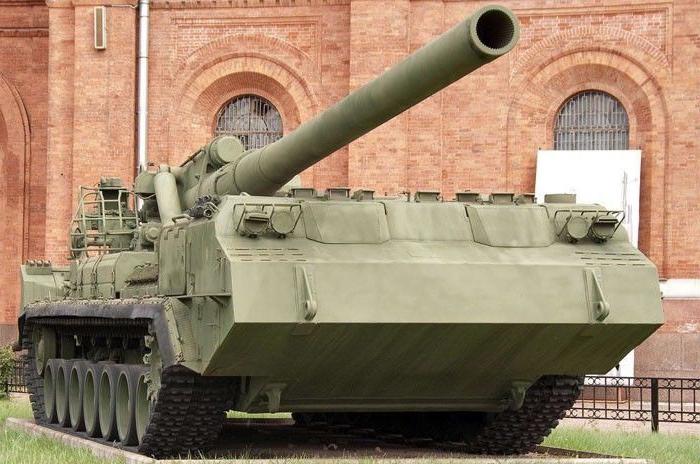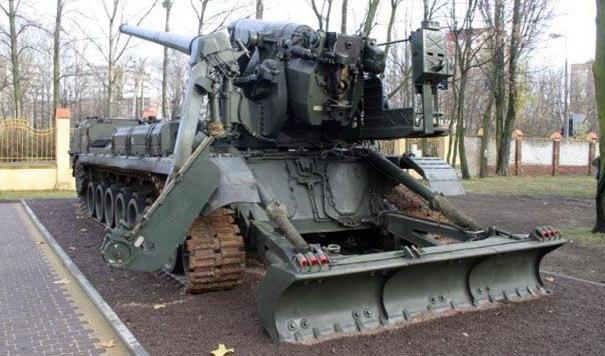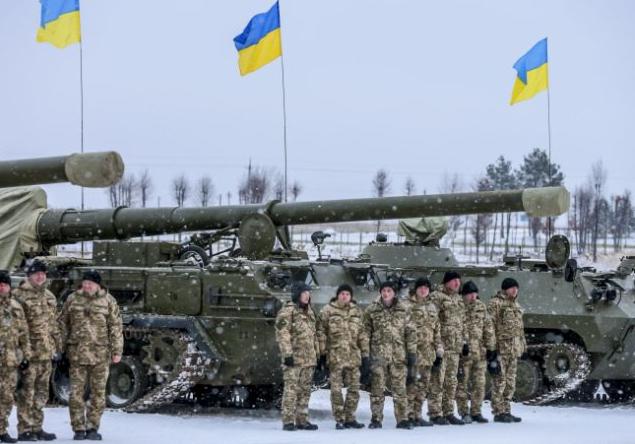The confrontation between NATO military groups and the Warsaw Pact countries in the late sixties and early seventies escalated. The events in Czechoslovakia, the constant buildup of the US nuclear presence against the backdrop of the ongoing Vietnam War, numerous regional conflicts - all of these aroused the most pessimistic expectations regarding a peaceful future. The USSR military doctrine provided not just a reflection of possible aggression, but an instant transition to offensive operations with the aim of transferring the zone of active operations to foreign territory. To implement this plan, powerful military groups were created in the western part of the USSR, united in districts. In the event of a conflict, they should have crushed the fortified lines of a likely enemy by many types of weapons, not only defensive, but also offensive. One of these tools was the self-propelled howitzer 2S7 "Peony", capable of firing not only with conventional (blasting), but also with special charges. In military language, nuclear weapons are called that.

Historical background
The first Soviet atomic charge was successfully tested in 1949. But it is not enough to possess weapons of mass destruction, for its use delivery vehicles are needed. At that time, the only way to launch a nuclear strike was through aerial bombardment, and the Stalinist USSR had only one type of aircraft at its disposal, capable of carrying a many-ton terrible burden over a fairly large distance. The Tu-4 was copied from the American B-29, previously "distinguished" by strikes on Hiroshima and Nagasaki. But the Soviet artillery systems were considered unsurpassed, and one of the first was the idea of using them for firing atomic bombs of small power. Later, more than two decades later, the Peony howitzer became a real reification of this design idea, and then, in the early fifties, they tried to realize it, but not very successfully. Tests of the 2A3 self-propelled gun and 2B1 heavy mortar revealed a number of fundamental flaws in these systems, mainly due to their bulkiness and heavy weight. During the reign of N. S. Khrushchev, artillery was no longer considered a modern type of weapon. It turned out prematurely.
Tactical task
During a large-scale strategic offensive operation, according to military theorists and commanders, in its first phase it is necessary to suppress the centers of resistance, plunge the enemy’s communications and control systems into chaos, thereby causing the most damage to its defenses. To accomplish this task, tactical missiles, bomber and attack aircraft and other means of fire, including long-range artillery, are used in our time. The advantage of the latter is the relative cheapness of each shot (compared to missiles) and the difficulty of hitting a projectile with an atomic charge in flight. The gun should have a number of technical indicators, among which the main ones: firing range (at least 25 km, otherwise, troops will fall into the cloud of radiological contamination), a sufficient mass of the charge being thrown (about a centner) and rather high accuracy. Howitzer 2S7 "Peony" meets these requirements, moreover, today it is considered the most powerful artillery system in the world.

Reconciliation and tidying
Dry facts inform the modern reader that the development of self-propelled guns began in 1967, by the spring of 1970, the terms of reference were finalized, and by the mid-70s, the first copies of the new model began to arrive in the Soviet Army. However, soon the fairy tale affects, and the matter takes much longer. Howitzer "Peony" was born in agony. The first model, made of life-size wood, was rejected by the leadership of the USSR Ministry of Defense and specialists from the Leningrad Artillery Academy. Then there was a debate about the caliber, because the gun was intended not only for firing special charges, but also the usual mass-produced defense complex of shells. After long discussions, the customers stopped at 203 millimeters, proposed by the representatives of the Barricades factory as the optimal size. The choice of chassis was also difficult, the chassis of the T-10 and T-64 tanks did not fit due to a strong pullback. Ultimately, consensus was reached. The Kirov plant, as the lead developer, was tasked with designing the Peony howitzer. The gun was entrusted to the Barricades factory (Volgograd). Looking ahead, it can be noted that both enterprises successfully coped with the government task.

The layout of the armored hull
The layout scheme of self-propelled guns today seems simple, but its development required considerable effort. Howitzer 2C7 "Peony" consists of two main units, the chassis and the gun itself. The caterpillar chassis is divided into four compartments. In the control department, located in front, there are a car commander, a driver and one of the soldiers of the calculation. They are followed by a power compartment, a powerful diesel engine installation is mounted in it. The next section is intended for the camping and transport arrangement of three or two (depending on the modification) calculation members. Ammunition stockpiled there. Feed 2C7 "Peony" contains the gun and the opener, which is a kind of hydraulic bulldozer bucket. During firing, this device goes deeper into the ground by 70 cm and takes on recoil energy.
This combat vehicle does not have a rotating tower .
The case has a bulletproof two-layer reservation, which reduces the damaging effect of gamma radiation in half in the event of a nuclear strike.
The power of the power plant, represented by a V-46-1 diesel engine, is 750 liters. from. Autonomous power supply of the electrical system is carried out by a generator rotated by a 24-horsepower engine, also running on solar fuel. Mechanical transmission, tank (from T-72).
There are seven road wheels, they have individual hydraulic shock absorbers, a leading pair is front, a guide is rear.
In the design of the chassis, much attention was paid to maintainability and unification with units already tested on tanks.
Gun
Under the leadership of the chief designer G. I. Sergeyev, the design bureau of the Volgograd plant "Barricades" was able to create a unique tool. Monoblock design of the main assembly of any gun has been developed by common world practice. This means that the barrel and breech are made of one piece of metal, in one piece. This technology has its advantages, but it also has a significant drawback. The barrel of the gun from firing wears out, and in this case must be replaced completely, together with the breech. Howitzer "Peony", the cannon of which can be disassembled, is more difficult to manufacture, but easier to repair. The threaded part can be replaced even in the field. A similar design was proposed back in the 19th century by engineer A. Kolokoltsev from the Obukhov plant, but then it was not possible to implement it for technical reasons, and the idea of a talented Russian inventor was embodied.
In all other aspects, the Peony 203 mm howitzer is the most common weapon, albeit a very powerful one. The swinging part has a toothed arch to set the elevation angle to 60 °, an angle of turn in azimuth of 30 degrees is provided, there is no muzzle brake (this also gives its advantages in the form of a small high-pressure wave), a two-stroke piston shutter. But these details are of interest only to specialists.
How to charge
The standard ammunition of this gun is quite heavy, it can weigh up to 110 kg. Therefore, the self-propelled howitzer 2C7 "Peony" is equipped with a mechanical device with a manipulator and remote control. The projectile can be lifted from the ground or a truck, while the pointing angle does not need to be changed. The aiming, therefore, does not go astray. In emergency cases, special stretchers or a standard cart are also used.
Of particular note is the maximum degree of duplication of management mechanisms. In the event of failure or failure of the electrical system, hydraulics or pneumatics, any operation can be performed by mechanical means, simply by rotating the corresponding handle. It will be slower, but a combat mission is still possible.
The charge, equipped with a fuse and designed to communicate to the projectile the initial speed, is laid in the breech in fabric bags stored in special waterproof boxes. For such powerful guns, only the cap-shaped method of loading is applicable.
Guidance and communication
The Peony 203 mm howitzer is equipped with a simple and reliable guidance system. It is based on a panoramic sight of the PG-1M type, designed for shooting at horizontal targets. It is used when you need to fire direct fire. To shoot at remote, but visible objects, the gunners use another sight, OP4M-99A.
The optical complex also includes TNPO-160 periscopes in the amount of seven pieces, plus two similar ones located on hatches. Observation at night is carried out using infrared devices TVNE-4B.
Communication equipment is represented by an ultra-short-wave radio station R-123M and an internal intercom 1B116.
Malka
For fifteen years of military operation, the shortcomings that the Pion howitzer possessed were identified. The characteristics of the range and accuracy of the military were quite satisfactory, some running and operational indicators turned out to be a bottleneck. In addition, the loading time and the rate of fire associated with it and the inverse relationship also left much to be desired. By 1980, the gunners were no longer satisfied with the information capabilities of airborne equipment.
The modified self-propelled howitzer "Peony" received the index "M" and the code name "Malka". It differed from the prototype in a more powerful all-fuel engine (gasoline, kerosene and practically everything that burns for it), new firing control equipment (having a high degree of automation), an improved ammunition stacking system (now there are eight, twice as many originally carried the howitzer "Peony"). The undercarriage has also undergone modernization, as a result, the engine life has increased to 10 thousand km. Self-propelled gun systems received an indication of health monitoring.
The most important improvement concerned the rate of fire. The remote mechanism was redesigned, as a result of which the loading speed increased by 60% (up to 1 shot in 24 seconds). The danger of reciprocal destruction of the gun prompted the designers to provide a remote control option with digital indication of all firing processes from the command vehicle, in which the signals are transmitted via radio channels or wired communication.
Specifications
Firing at horizontal targets is the main combat mission for which the Peony howitzer was created. The firing range of the guns depends on the mass of the projectile. It can send a conventional high-explosive fragmentation 3VOF34 with a mass of explosives of 17.8 kg to a distance of 37.4 km. The active-reactive 3VOF35 flies further, by 47.5 km (according to some reports, even more than 55). The use of a 3BO15 cluster shell implies a combat use radius of just over 30 km.
Tactical nuclear special charge can be delivered at a distance of 30 km.
The initial velocity of the projectile provided by a full shotgun loading is 960 m / s.
Howitzer "Peony" can be transferred from marching to combat status in six minutes. The calculation is 14 people, of which half is transported in a combat vehicle, the rest in additional vehicles (BM, BMD, etc.)
Structurally for 2C7 "Peony" provides for the use of ammunition of various types. Concrete shells are designed to destroy buried and specially protected objects. The purpose of land mines and cluster charges is any accumulation of manpower of the enemy and his armored vehicles. In the event of a global conflict or a limited nuclear war, special charges, including chemical ones, with which the Peony howitzer can also fire, can be used. TTX significantly depend on the method of guidance and use of external sources of information about the dislocation of targets.
Active rockets are used when it is necessary to defeat very distant targets with increased accuracy. Correction of the trajectory is possible, including astrocosmic, but it is available only to Russian gunners.
At home and abroad
After the collapse of the Soviet Union, the self-propelled howitzer "Peony" was for various reasons in service with the armies of a dozen countries. Among them, the first successor to the USSR is the Russian Federation, which has 320 units, most of which are under conservation, Uzbekistan (48 pcs.), Belarus (36), Azerbaijan and Angola (12 each), Poland (there are eight 2C7 units here “ Peony ”, sold in 1989 by the Soviet Union, has already been withdrawn from service) and several other states. The weapon for regional conflicts most often seems excessively powerful. This leads to limited conditions for its use. In the fighting situation there was so far only one case when it was used, and very unsuccessfully, the Peony howitzer. Practically all the world media published a photo of a self-propelled gun seized from the Georgian army in August 2008. Five self-propelled guns were delivered by Ukraine, four of them were destroyed, one was on the list of trophies of the Russian Army.

There is only a small list of situations in which the Peony howitzer can justifiably be used. The characteristics of this weapon are such that it is of little use for fighting point targets. This means of combat was created for the delivery of tactical nuclear weapons. When using special charges, the expansion relative to the target, measured in tens of meters, does not matter much. Therefore, military specialists should take into account the capabilities and characteristics that the Peony howitzer has. In Ukraine, about a hundred guns of this type remained after the collapse of the USSR. For 23 years they stood quietly in warehouses in grease. The conflict in the Southeast prompted the country's leadership to give the order to de-conserve several units and bring them into combat-ready condition. Will the Peony howitzer shoot? The photos of heavy installations loaded onto railway platforms should, in theory, inspire the idea of an imminent victory ... But we sincerely hope that things will not come to their use.